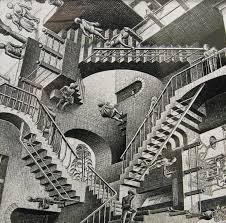To help me explore Hisham Matar’s The Return: Fathers, Sons, and the Land In Between (2016), I ordered a sneeze-inducing, water-stained copy of Knud Holmboe’s Desert Encounter: An Adventurous Journey Through Italian Africa (my copy was printed in 1937), re-read parts of Alessandro Spina’s Confines of the Shadow epic, and even, among other things, pulled Dante off the shelf:

In a piece that ran on Warscapes, I looked at the books nested within Matar’s The Return. It opens:
Hisham Matar’s new memoir The Return: Fathers, Sons and the Land In Between is several books at once, depending on which way you hold it to the light. Any text depends on the light a reader’s gaze lends it. Yet The Return is particularly, dazzlingly multiple: memoir, geography, biography, journalism, literary criticism, and dark historical thriller.
The effect is startling in The Return’s brief 240 pages, but Matar achieves it, in part, by folding in so many other books. We can unfold many of them and pull them out, like the hidden rooms of a child’s pop-up book. Most of these rooms themselves contain further hidden spaces, which extend not just the story of fatherhood and Matar’s family, but of modern Libya.
At its surface, Matar’s memoir promises the “true” story that has undergirded his two fictions: The real Hisham Matar returns to Libya in 2012 to search for echoes of his father, the activist-industrialist Jaballa Matar. The author’s father was kidnapped in Egypt in 1989, where the family was living in exile, and handed over to Moammar Ghaddafi.
After that, Jaballa Matar was taken to the notorious Abu Salim prison. He was never seen outside it again.
This is Jaballa’s story, but his son cannot approach it directly. Its roots sink down a hundred years, into the time of Grandfather Hamed, Jaballa’s father. Hamed’s age is unknown, but he certainly came of age in the nineteenth century, during Libya’s Ottoman era, and fought the coming of Italian colonial rule. Like his son, Grandfather Hamed was kidnapped and sent off, probably to be executed. But Hamed escaped his Italian captors and fled to Egypt.
Grandfather Hamed eventually returned to Libya and built a home in the village of Blo’thaah. This was no ordinary village home. When Hisham Matar was a boy, he writes, the place seemed “as mysterious and magical as a maze.”
I often lost my way in its endless rooms, corridors, and courtyards. Some windows looked out onto the street, some onto one of the courtyards, yet others, strangely, looked into other rooms. It was never quite clear whether you were indoors or outdoors. Some of its halls and corridors were roofless or had an opening through which a shaft of light leant in and turned with the hours. Some of its staircases took you outside, under the open sky, before winding back in.
This Escheresque—or Grandfather Hamedesque—architecture is echoed in the construction of Matar’s The Return, which blossoms in dozens of unexpected ways, often winding back in to rooms that now appear different. Perhaps it was the only way of telling a story where so many of the facts have been suppressed, shredded, or hidden.
Keep reading on Warscapes.
Click HERE to read more

Be the first to comment